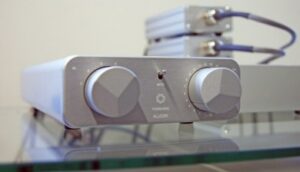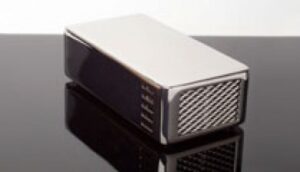THE RIGHT FOUNDATION OF A GREAT SYSTEM: SEISMIC ISOLATION
Vibration from the ground is a now universally accepted as major reason for the variability in the performance of audio equipment.
However mild a vibration may seem to us, it will be huge compared with the minute domain in which hi-fi systems process signal information.
Just think, if the vibrations have just successfully traversed through millions of tones of earth, what effect is a little extra mass placed under the equipment going to have?
No, the only solution is to employ a low pass mechanical filter, comprising mass, compliance and proportional damping, which isolates from 3.5Hz and up as in The Townshend Seismic isolation range of products.
The ideal compliant medium is a high tensile carbon steel spring, which allows unimpeded movement in all three dimensions. When supporting the mass of the equipment it all acts as a low pass filter, decoupling the component from the floor from virtually all harmful vibration.
A progressive air damping device rapidly slows large oscillations caused when the equipment is disturbed, but becomes inactive when the equipment is at rest.
Whereas conventional supports, such as spikes and cones have very poor isolation and act mainly as vibration couplers. Sorbothane isolates in the vertical plane above 50 Hz, with minimal isolation in the horizontal plane.
It has taken Townshend Audio 25 years to perfect its latest comprehensive range of isolation products which are now available to isolate all source components and speakers.
Seismic Isolation Platform under Rega RP6 Turntable, Leema Antila CD Player & Naim UnitiLite:
”Massive increase in stereo three dimensionality, sound is cleaner”
“A degree of hardness has disappeared and left a stronger sense of timing.” “Bass goes deeper” “Voice has regained its full richness. Quite a transformation in truth, and one that you’d be hard pressed to replicate with any similarly priced upgrade.” “The Townshend Seismic Platform seems able to transform the potential of electronic components as well as, if not better than turntables.” “What is clear is that few hi fi components give their best without isolation and the platform delivers as much in a neat and effective package and comes highly recommended.”
Hi-Fi Choice (Dec 2013) – Jason Kennedy
Seismic Isolation Platform under B&W 800
“Seriously impressed by the effect of the Seismic ‘spring-decoupling’ rather than the usual spiking for the loudspeakers….” “…the benefits of decoupling were immediate and surprisingly obvious…..giving notable improvements in imaging and clarity in general…”?“…human voices in particular seemed more real and believable, while clarity and information through the bass region was substantially enhanced, with better discrimination between notes and significantly less coloration…” “This is certainly one of the more cost-effective upgrades I’ve uncounted recently…”
HiFi Critic (Jul,Aug,Sep 2013) – Paul Messenger
The graph plots transmissibility, which is the vibration of the surface relative to the vibration of a piece of equipment on the surface vs frequency for different vibration control components under the equipment.
With nothing in-between, the plot is a straight line with a transmissibility of 1 where the equipment moves with the surface and it is clear that all vibration affecting sound is transmitted.
The black plot is typical of rigid cone, point or spike suspension where the point supports on the equipment cause localised bending and flexing with associated resonances, depending on point position and frequency.
There will be an inevitable small change in the sound.
The second plot is that typical of compressible elastomers such as Sorbothane or squash balls.
There is isolation above 50 Hz, but there is a lot of low frequency degrading vibration transmitted.
The third plot shows the Seismic Vibration Isolation. There is a slight amplification due to spring/mass resonance at 2.5Hz, but that frequency is so low it has no effect on the sound.
As the frequency increases, however, it is clear that there is significant isolation in the critical 5 Hz and up, where the reduction in vibration is increasing at a staggering 20dB per octave.
The resulting improvement in sound quality is clearly audible to all.
Link to the page: ” The importance of vibration isolation “









